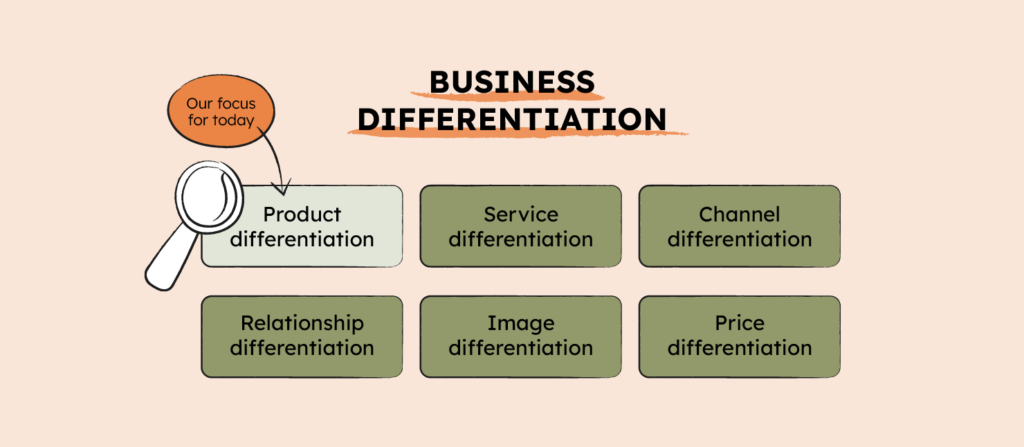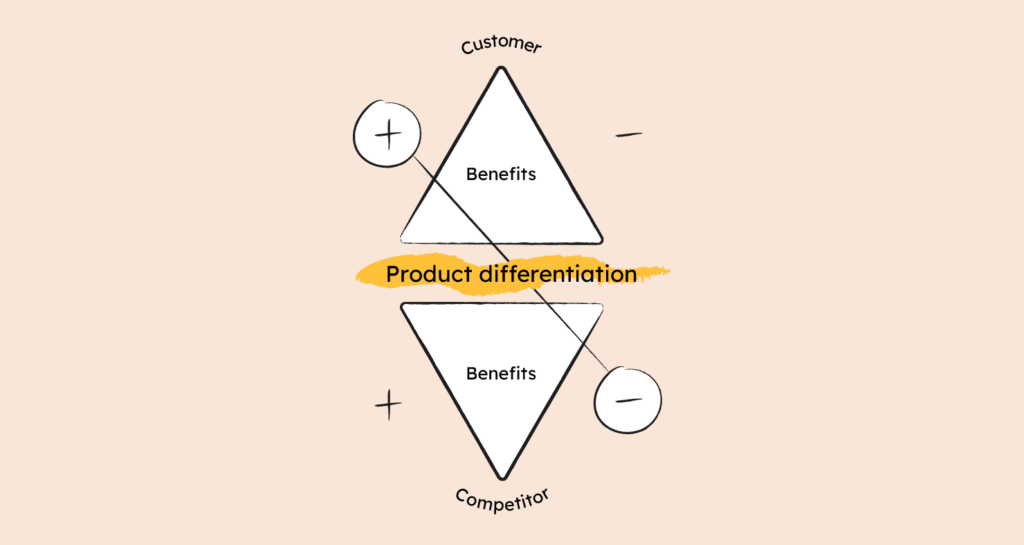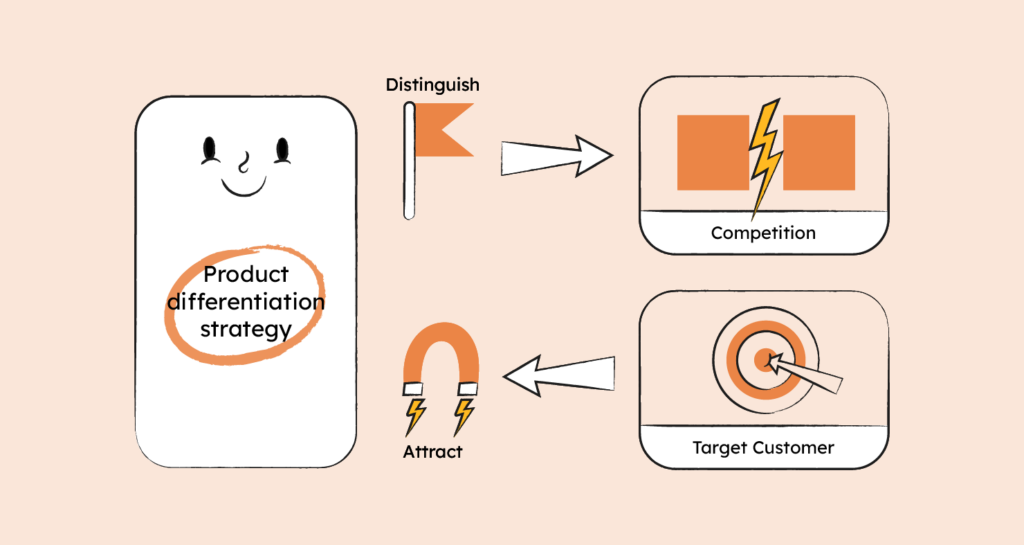Successful product differentiation is key to success. A product’s unique selling proposition (USP) should speak to how it resolves a specific pain point, as no product has ever done before. It promises a truly mind-blowing experience that instantly turns first-time buyers into raving fans.
Who is king in the world of the blind when there isn’t even a one-eyed man ?
JOHN KENNETH GALBRAITH
This is how I often feel when persuaded to try a new product introduced to the market.
The products that do manage to differentiate reap the rewards. But unfortunately, most attempts at standing out are grossly disappointing.
There’s a reason why 95% of all new products fail. The inability to differentiate successfully is a major contributor.
In this article, I will provide you with insights into why product differentiation is essential, how to do it, and how to know if you’ve been successful.
What is product differentiation?
Product differentiation is a way to distinguish yourself in a competitive market and make your product unique in the eyes of your target audience.
It is one of the elements of business differentiation and a key factor in any flourishing business.

Product differentiation is the most visible aspect of the business differentiation types. It includes the physical and perceived characteristics that add to the desirability of your product.
When executed well, product differentiation delivers various benefits.
- It boosts brand loyalty. By building better, stickier products, you can maximize product adoption, turn first-time customers into regulars, and regulars into product champions.
- It helps you target the right audience. Jack of all trades, master of none. If your product can do many things, but none particularly well, it will be more difficult to position it in the market. If you don’t know what exact value the product brings and what makes it stand out, your target audience won’t know either.
- It helps you create a truly unique product. Product differentiation helps to bring focus and allows you to go further on fewer, as you are focussing on the unique qualities of the product. Those unique qualities can then be showcased in marketing and advertising activities, in a compelling and powerful manner.
- It gives you a better position to gain a competitive advantage. Customers will perceive your product as superior to that of competitors, as it better caters to their specific needs. Done successfully, it gives customers the impression that there is no alternative product in the market.
The Three Types of Product Differentiation
Three is the magic number. Let’s look at the three product differentiation types and some examples of differentiation in action.
Objective measure (Vertical Differentiation)
Vertical product differentiation is when a customer chooses to use an objective measure to select the product of preference. Customers might make a choice based on specific factors; where for one person availability can be the deciding factor, while another might focus on durability.
Example:
For sneaker collectors, a product's exclusivity could be a deciding factor, or it might be the product's durability—meaning whether or not the sneaker falls apart after walking 50 miles.
Subjective measure (Horizontal Differentiation)
The beauty of us humans? We don’t always make our decisions on objective factors. This is where horizontal product differentiation comes into play. Customers sometimes make decisions based on personal preference instead of objective measurements. One of my personal favorite books that speaks to this topic is Dan Ariely’s Predictably Irrational.
Example:
A sneaker that has a really eye-catching, stand-out design.
Best of both worlds (Mixed Differentiations)
As with most things in life, one does not exclude the other and there is a balance to be struck. Customers tend to consider both of the aforementioned differentiations.
Example:
For someone who likes hiking and the outdoors, a sneaker that stands out and attracts a lot of compliments might only be a deciding factor if the sneaker is also comfortable and durable.
How Do You Know if You’ve Differentiated Your Product in the Marketplace?
Getting started with product differentiation might be overwhelming, as it presents a wide variety of options. Besides asking yourself how to distinguish your product, you might wonder — how do I know if I have differentiated?
Successful product differentiation revolves around three components (there is that number again).
- The target customer
- The competition
- The product differentiation strategy
You are successful when your target audience validates the desirability of attributes, which makes the product vastly superior and unique to that of your competitors.

In other words:
- Delivering the benefits your customer is looking for,
- Which no competitor has been able to resolve,
- In a way that speaks to your customer,
...is where the product differentiation magic happens.
Mastering the needs of your ideal customer
95% of companies do not know their customers’ top buying criteria. This means that even if companies want to differentiate, there is a good chance they won’t be able to do so successfully, as they simply aren't in touch with what customers want. As a result, they only have a vague idea, if any, what makes the product desirable to potential customers.
So, this step is crucial for building brand loyalty: Figure out who your target customers are, master their needs, and address them in a unique way.
Here are some techniques to try that you might find beneficial:
- 1:1 interviews with people in your target market
- Customer observations
- Focus groups
- Surveys
These insights, combined with the right tools, can be really powerful for your differentiation strategy. Here are a few tools for capturing customer insights that are great to have in your product management toolbox:
Example:
Meet Sky Jones, a woman in her late 30s. Sky has been a "sneakerhead" for 20 years and is always looking for a special pair to add to her impressive collection. When she finds a pair with an exclusive or innovative feature, she grabs one to rock and one to stock. She is frustrated that the new sneakers on the market are mainly reworks of previous best-selling pairs. The sneakers she's drawn to don’t necessarily emphasize value-for-money. She expects the sneakers to be both high-quality and exclusive.
Understanding the competitive landscape
To win any game, you need to know who you are playing against and what their weaknesses are. Figure out who else is targeting your ideal customer profile. Who are they, what do they offer, what makes their offering unique, what is their marketing strategy, what are their strengths and weaknesses, and — for the Public Enemy listeners reading this — what is the opportunity to “Shut em Down”?
By uncovering the competitive landscape you can interpret what works well, what to avoid, and how to stand out.
Competitive analysis is a great tool for outsmarting your rivals.
Example:
Nike has a large, active, and supportive community consisting of brand advocates who give potential buyers the confidence to pull the trigger and "cop a pair" as well. How did they achieve it? By offering an amazingly high-quality and exclusive product, yes—but also through marketing efforts that emphasize the 'lifestyle' associated with their brand.
Choosing your product differentiation strategy
The product differentiation strategy speaks to the product attributes that make it unique. A great one goes hand in hand with other aspects of your business differentiation strategy. For instance, a high-quality product will allow you to ask for a higher price.
The following areas define your product differentiation strategy.
Product features
This is probably the most popular differentiation point—the unique features that provide an exceptional experience.
What are the customer needs your competitors haven’t solved yet, or haven't solved adequately? The features that exceed customer expectations and create a WOW factor are the ones that will differentiate you from your competitor.
When Kyocera introduced its VP-210 phone back in 1999, it was the first commercial cellphone with a color camera. Talk about a standout feature!
Product quality
One strategy is to look at the quality of the product. Using the best-quality, durable materials, and having impeccable reliability or warranty, draws attention.
This does mean that you have to be sure to have evidence to back up the claim that your product and production process are unique, high-end, and phenomenal.
Nintendo’s Virtual Boy jumps to mind here as a product that failed to deliver on the quality promise. It failed epically due to low-resolution graphics, horrible gameplay, and people experiencing nausea while playing it. Not exactly the kind of immersive experience your customers are looking for.
The power of effectiveness
Another differentiation strategy is to focus on how effectively your product can remedy specific pain points and cater to the underserved needs of the customer.
Hugo Boss, with its “complete your look” feature, does an excellent job here for those shopping for a new outfit. The feature proposes complementary garments when shopping for a certain item, making it easier and faster to purchase a cohesive outfit. Smart!

Innovate to dominate
This strategy is tricky, the reason being that it often involves going after an "unknown unknown." What is an "unknown unknown?" The Known-Unknown matrix is a design thinking tool that can also be used when discussing the importance of a feature. The unknown — unknown in this case are those needs customers don’t know they have nor understand.
Apple’s iPod is a success story most will recognize. Apple managed to understand what its customers wanted and needed better than the customers did themselves.
Make thinking visible through design
This particular approach asks the questions, "how appealing is our product design to our ideal customer?"
This can mean differentiating on the intuitiveness of the design, the product's physical consistency, the colors of the packaging—just to name a few. With a unique visual design, you immediately get your customer’s attention.
When you stroll through the drugstore shampoo aisle, you can see quite clearly how differentiating aesthetics make certain products appeal more to specific target audiences and persuade them to buy the product. The formulation of each product may even be quite similar, but the differentiation is immediately apparent. For example, sleeker packaging comes off as higher-end, and gunmetal gray bottles suggest the product is aimed at men.
Product differentiation validation is a continuous effort
Once you've truly taken time to understand your customers' needs, you can invite customers to experience and use your product. You can never have too much customer feedback, so capture as much as you can!
Next, research the competitive landscape, and see how you stack up.
Cross-referencing what your customers say about your product versus what customers say about competitors in your space will often provide you with ideas for your differentiation strategy.
When the outcome is that more potential customers are attracted to your product and confirm you increasingly distinguish yourself from your competition, it is fair to say you either have or are on the right track to differentiation in the marketplace. But that doesn't mean it's time to rest on your laurels.

Keep in mind that product differentiation is not a one-time effort. The world changes and customers change with it, so ongoing assessment of customer needs, market trends, and competitors will be needed as long as your product exists.
Example:
Imagine you are working for a sneaker brand that is the market leader. The brand offers a state-of-the-art self-lacing sneaker that keeps your feet smelling pleasant, using a releasing mechanism equipped with your favorite fragrance. If the sneaker has proven to be successful, you can bet your sneaker collection on it that competitors are doing their utmost to either replicate or further innovate the product.
Measuring Product Differentiation
The proof is in the pudding—it is always essential to measure success, and pivot or course-correct when needed, using the metrics that matter.
Let’s pause for a second and remember, in most cases, it's all about the money (it’s all ‘bout the dum dum da da dum dum). There is a good chance your product differentiation efforts are all in the service of increasing market share and growing monthly recurring revenue.
Now let’s unpause. Your product strategy is goal- and outcome-driven. It aims to move the needle on KPIs and metrics, validating your success. Your task is to define the KPIs and metrics to track, collect data, analyze them, and use the insights to celebrate success or take further action.

Define your product differentiation goals and objectives
Define what it is you aim to achieve with your efforts. What are you aiming to get out of your differentiation strategy?
Example:
Sell more sneakers in the next year.
Key Performance Indicators (KPIs)
Now how do you gauge the goals? How is the product differentiation strategy contributing to reaching the objectives?
Enter key performance indicators. These are the quantifiable indicators of progress toward achieving your goals.
Example:
Grow sales in the accessible footwear segment by 5% in the next year.
Metrics that matter
Based on the chosen strategy, select the metrics. Metrics are the quantifiable data relevant to the performance.
Example:
The customer acquisition rate for a new line of sneakers that is both comfortable and easy to put on and take off, catering to the needs of those that have a disability or the adoption rate.
Is our product different enough?
It’s bound to happen at one point that the question arises — “is our product different enough?”
Sorry to say, but this is a difficult question to answer. First, let’s recognize when it doesn’t matter whether your product is unique:
- When you have a significant market share
- When familiarity is the key distinguisher
Didn’t tick either of these boxes and still want to know if your product is different enough? Time to try competitive analysis.
What insight does competitive analysis offer?
In your competitive analysis, there are several ways to mine your competitors for valuable insights.
- The key product features of your competitors can tell you what they're doing to be unique
- These same competitor product features also show their ability to catch up with the uniqueness of other competitors.
- A SWOT analysis can provide insights into the Strengths, Weaknesses, Opportunities, and Threats of your competitors. Monitoring and reevaluating them periodically will give you an idea of how well you are differentiating.
What do your customers tell you?
The customer is king, and that also applies to product differentiation. What are your customers telling you about how they perceive your product?
Collect information, analyze it and use the insights from:
- Customer feedback
- Feature requests
- Customer reviews
- Surveys
- Communities
Value and Differentiation
Being different shouldn’t be an objective in itself. It is a balance between being unique and making sense. If your uniqueness doesn’t generate any additional revenue, it's not doing you any favors.
For instance, deliberately selling a range of your products at lower prices might well harm your brand image. Existing customers might lose the feeling of being special and purchase another brand that does make them feel that way.
It is important to do market research and understand what similar products or substitutes are doing, what the customer needs are, and how those insights can help you create a differentiated product that speaks to potential customers.
The Bottom Line
Product differentiation is a vital element of doing business, and every company has to get it right. Understanding customer needs and the competitive landscape is essential to creating a successful product differentiation strategy. To be successful, it's on you to set out clear objectives, and use key performance indicators, and metrics to measure progress toward reaching them. Avoid treating product differentiation as a one-off. Your competitors are eager to show you why.
Enjoyed this article? Don't forget to subscribe to our newsletter for more expert insights and product management resources.





